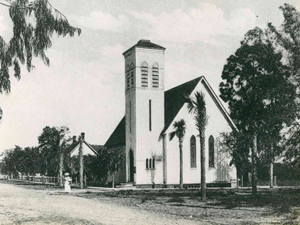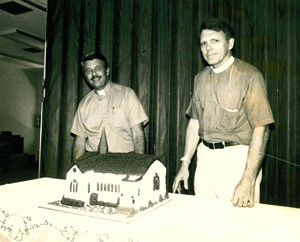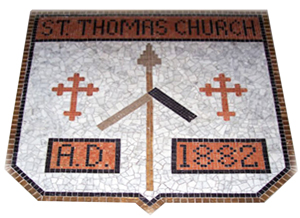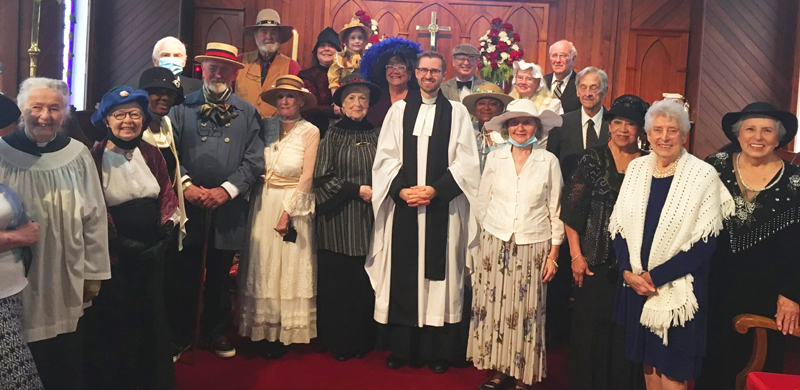“St. Thomas is a traditional community rooted in the celebration of the sacraments of the Church. We were founded in 1882 to worship and adore God, to pray and study together, and to lovingly serve God and our neighbors. We will continue to be faithful to the mission God has given us and we know that if we do, God will do amazing things in this place, just as he always has.”
-Fr Matthew Perreault, XIII Rector of St. Thomas

On March 14, 1882, friends of the Protestant Episcopal Church of Lake Eustis met at the home of A.D. Key to organize a new church. L.D. Prescott donated a lot at the corner of Lemon Avenue and Mary Street for a church building, and a finance committee was organized. At the next meeting, the site committee reported that they had met with Mr. Prescott and “had the deed duly made out and in hand. They were warmly applauded.” The committee had done so well, that they were empowered to solicit plans for a building not to exceed $1,500.
During the April 6, 1882 meeting, it was decided to get pledges for the proposed building on Easter Sunday. The list of those who pledged included many names still familiar to area residents: Starbird, Stevens, King, St. Clair Abrams, Titcomb, Hazzard, Ward, Gottsche, Macdonald, Clifford, and Norton.
A history of the congregation stated: “St. Thomas’ Mission is in a growing section of the state, just east of Ocklawaha Lakes, having the thriving villages of Fort Mason, Tavares, Mount Dora, Royalieu and Edwards within a circuit of five miles. It does not depend on transient visitors for strength, having over 20 resident communicants.” It went on to say, “90 percent of the building fund was raised from persons living within 4 miles of the church.”
The plans were decided based on the Gothic Revival style, commonly known as Carpenter Gothic. The orientation of the church to the points of the compass was a Gothic tradition. The altar was located on the east end of the church necessitating the congregation to face that direction.
On May 7, 1882, “at a meeting held after the service, by the congregation then assembled, it was unanimously decided to call this the St. Thomas’ Episcopal Mission of Lake Eustis, and so ordered to be recorded on the minutes.” Two weeks later the plans for the church were officially adopted and turned over to the building committee. A contract was signed by M.L. Osborne to build the 24-foot by 63-foot church for $1,840 on June 15, 1882, and the cornerstone was laid on the afternoon of the last Sunday in November before a large, community-wide congregation.

The first service in the completed building was held on March 4, 1883. In August of that year, the vestry was “authorized to make the last payment to the contractor and to buy locks and keys for the doors.”
It took several years to complete the interior: pews, lamps, chancel furniture, a heating stove, and to get the windows fitted. Churches in Pennsylvania and Massachusetts sent gifts: Bible, Prayer Book, Hymnal, and baptismal font. The church was consecrated on April 13, 1890, by Bishop Weed and is the oldest church building in Eustis. In his charge to the parish, Bishop Weed exhorted the people of St. Thomas Church to be ardent in worship, constant in prayer, and generous in service. His charge continues to form the foundation of God’s mission for St. Thomas today.
In 1921, the exterior of the church building was stuccoed over the original board and batten. Making space for a new organ necessitated a major structural change in 1930. The church was lengthened 18 feet by splitting the building and moving the east end farther east. The new chancel was furnished, a new altar installed, and the pipe organ added. This cost $16,000, and the new organ, $5,000.
In 1953, memorial lights in honor of the Rev. D.T. Johnson, the first rector of St. Thomas was dedicated. These hanging lanterns in the nave and chancel were specially designed and made for the church. Besides, the completed memorial included a new vestibule lantern, choir lights, and a bronze plaque.
A parish hall, now the building called “Wisdom Hall”, was added to the east of the church as a gift from Clara Palmer, who had used the building as a school. It was originally built on the corner of Orange Avenue and Dewey Street and served as Eustis’ first kindergarten in 1906. In 1935, it was moved to its present site by rolling on huge logs down the streets of Eustis.
A new Parish Hall was built and dedicated in January 2000 and is located at 616 Lemon Avenue. It seats 200 and features a full commercial kitchen and handicapped-accessible restrooms. There is now a covered walkway from the church to Wisdom Hall, the Parish Hall, and the Sunday School rooms and nursery. Following renovations in 2005-2006, Wisdom Hall currently houses a beautiful Craft Shop, a small, formal parlor, and the Choir Room for practice and vesting.

The Office Building, south of the church on Mary Street, was originally built as a rectory in 1924. This building presently houses the Rector’s office, the Administrator’s office, the Conference Room, and a welcoming waiting room.
The Women’s Auxiliary established a “Treasure Shop” in the Mantey Home (Guild House) which stood where the present-day Memorial Garden is located. It was later razed to allow enough room for the Church School Building. The women sold second-hand articles and clothing. In 1977, from the “Treasure Shop” funds, a house at 203 S. Mary Street was purchased. Now at 211 S. Mary Street, the current St. Thomas Thrift Shop continues to provide quality new and gently-used merchandise for sale to the public, with all proceeds being used to fund community outreach projects.
In 2007, the parish celebrated its quasquicentennial which was commemorated with a tile mosaic commissioned for the floor of the Narthex. In 2021, St. Thomas welcomed its thirteenth, and current, rector, Fr. Matthew Perreault. The Parish celebrated its 140th anniversary Patronal Festival on January 2nd, 2022 to begin a year of jubilee celebrations. The Patronal Festival was a special mass using the liturgy of the 1789 Prayer Book which was still in use in 1882 when the parish was founded. Parishioners celebrated the Patronal Festival dressed in era appropriate clothing, and a reception followed in the parish hall using similarly appropriate foods.
The 140th anniversary which began with the Patronal Festival, also involved the establishment of a permanent chapel in Wisdom Hall, the rededication of the Church School Building, the establishment and blessing of the St. Francis Garden, and the 140th Anniversary Bazaar.

